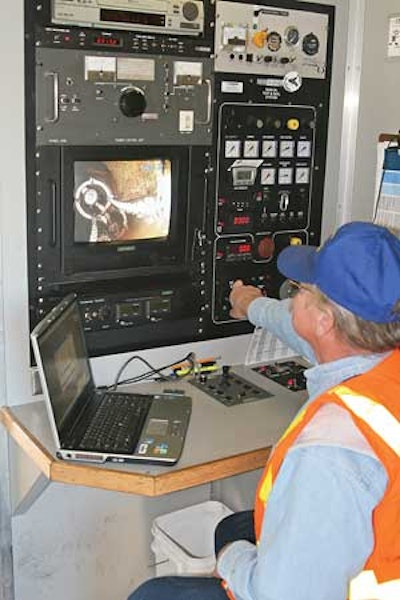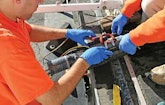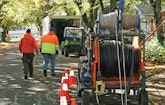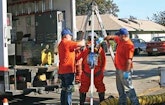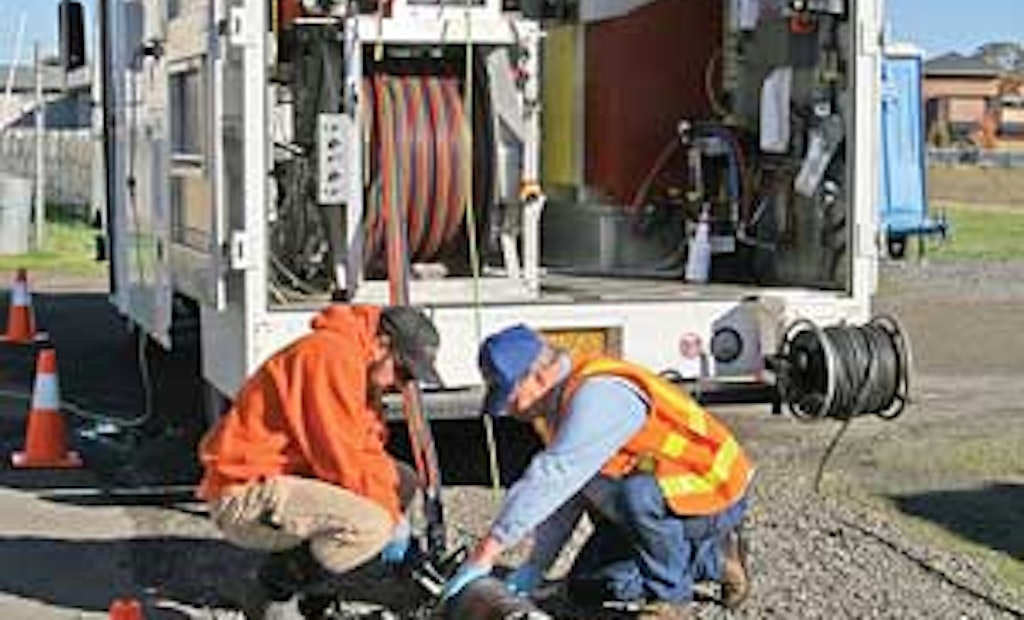Interested in Manholes?
Get Manholes articles, news and videos right in your inbox! Sign up now.
Manholes + Get AlertsWastewater Collection Services in Salem, Ore., has come a long way since its grouting van was a converted horse trailer towed by a pickup truck transporting the camera equipment.
The city’s sewers, mostly 4- to 75-inch concrete pipe with some brick and vitrified clay tile, date to 1910. With 65 percent of 785 miles of pipe compromised by grease, roots, defective service lateral connections or structural damage, the 36-member department meets the challenges with an aggressive inspection and maintenance program.
Grouting has been an integral part of the city’s inflow and infiltration (I&I) control program since 1971. “Bringing the work in-house instead of hiring contractors saves the taxpayers thousands of dollars a year and enables us to accomplish more even with a shrinking budget,” says Jeff Winchester, supervisor of the TV inspection and grouting section.
In 2008, the city invested in cured-in-place sectional liners to repair defective pipe in inaccessible easements, and dedicated a four-man crew to the job. Last fall, the men received training on how to install saddle liners to seal broken lateral connections. The department’s efforts have reduced SSOs from an average of 50 a year throughout the 1990s to 15 in 2009. Just one of those was storm-related — the rest were due to roots or grease blockages.
Cost evaluations
Salem, built along the Willamette River and floodplain, has a high seasonally perched water table at 5 to 10 feet below the surface. During the wet season, October to April, sewers with bad joints act like dewatering systems. Once the water table drops, exfiltration occurs through the openings.
Wastewater Collection Services has 10 workers in the TV inspection section, another 10 in hydrocleaning, 10 in repairs, and six in technical support. Repair crews excavate and replace pipe or do sectional and saddle CIPP rehabilitation. Technical support handles paperwork, manages the map work and asset management database from Hansen Information Technologies (Infor Public Sector), and generates work orders.
In 2007/08, Jerry Smith, a sewer maintenance technician in the TV inspection section, conducted an asset study to determine the remaining extent of I&I and the cost of repairs. The study identified defects in 11,475 joints; 9,198 lateral connections; and 1,803 manholes. Smith compiled his findings in a PowerPoint presentation for city officials.
“The numbers were eye-popping, even when Jerry used the lowest amounts,” says Winchester. “For example, 3,300 joints leaking one gallon per minute equals 1.74 billion gallons per year. Our estimated treatment cost for that is 7 cents per 100 gallons, or $1.2 million per year.”
While gathering data, Smith discovered that I&I defects had been historically under-reported because inspectors had counted consecutive similar defects as one. “The old reports read, ‘I&I medium (1 to 5 gpm) 5 to 110 feet,’ instead of recording 21 leaking joints in that section,” says Winchester.
Savings add up
Grouting, at $5.04 per foot, proved the most economical solution because the barrels of concrete pipes were usually in stable condition. “Half the grouting cost is labor and equipment, and the other half is the injection chemical,” says Winchester. From 2007 to 2010, the city grouted 17,913 feet, 11,876 feet, 3,800 feet, and 10,700 feet for a cost of $19,152 to $90,282. Winchester projects 18,000 feet for 2011.
To understand the savings, Winchester cites a case when the city hired a contractor in 2007 to air-test 87 joints in 760 feet of 36-inch concrete pipe. The contractor found 22 defective joints and used 220 gallons of grout to seal them.
“It took him two days and cost us $50,000,” says Winchester. “We could have done the same project for $4,375, but we didn’t have a 36-inch packer at the time. Based on those figures, if the city were to contract for the testing and sealing of 51,000 feet of 36-inch pipe, it would cost $3.4 million. Our people can do the same amount of work for just under $300,000.”
That episode convinced the city to spend $30,000 on more grout packers from Logiball. From 2005 to 2007, it purchased 10 units for pipes from 8 to 36 inches. To grout a defect, a winch pulls the packer and camera downstream. Guided by the camera, the technician positions the packer at a joint, then inflates the ends to seal them against the pipe wall.
Separate hoses deliver the two-part AV100 chemical grout from Avanti International to the packer. Once injected, the grout fills the annular space around the packer, flows out the defective joint into the soil, and gels to form the seal.
This year, the city bought a lateral launcher from Logiball. The unit cleans 4- to 6-inch laterals as far as 50 feet from the connection. A motor, winched in tandem with the camera, rotates the launcher’s guiding arm and sewer nozzle. When the water pump is turned on, back jets propel the hose into the lateral for cleaning and removing roots, grease and other buildups.
Building the fleet
In 1978, the city purchased a TV/grout step van, mainline packer, reinstatement tool, and Avanti grout from CUES Inc. In 2008, the city added four TV box-on-chassis trucks and one grouting van.
Inspection equipment includes color zoom-pan-tilt cameras with wheeled and tracked transporters and Seeker portable push cameras from Aries Industries. Two transporters have LETS lateral evaluation systems with PE3600 pan-and-tilt push cameras, also from Aries.
A main concern for Winchester is the potential for cave-ins when sections of sewer fail. “Salem experiences a lot of sinkholes that are always about to collapse the street,” he says. “When dispatch reports one, we respond within an hour.”
One of the worst sinkholes formed a 2-inch-deep depression in the center of a major downtown intersection. The street department filled the hole with cold mix, then a dye test confirmed the damaged line to be an 18-inch concrete pipe buried 14 feet deep. “We decided to air-test and seal the entire 440 feet of sewer,” says Winchester. “That project was especially difficult because of the depth, location, and working at night to avoid disrupting traffic or compromising public safety.”
The city learned early on that successful grouting needs a technician who knows how to apply grout. That man is Ric Hines, a sewer instrument technician with 27 years of grouting experience. Hines, with an assistant to ensure his safety, worked manhole to manhole for three nights. He air-tested 176 joints and sealed 175 using a Logiball mainline packer and 616 gallons of Avanti grout. The job cost $7,000.
“We looked at all repair options,” says Winchester. “Hiring a grouting contractor averaged $30,000, rehabilitating the section with CIPP pipe averaged $80,000, and replacing the pipe averaged $400,000. It was a very demanding job, and I’m really proud of Ric and his crew. He’s a take-charge individual and a huge asset to our department.”
Another demanding job at which Hines excels is sealing joints in 2-foot lengths of 8-inch concrete pipe. “It’s touchy work and almost impossible to see the next joint without a pan-and-tilt camera,” says Winchester.
“Setting up the packer requires an operator with finesse and a steady hand. Ric has both. A city is wise to search for an experienced technician, because the money he will save taxpayers will more than cover his salary.”
Sustaining flows
Salem’s I&I program includes inspecting and cleaning problem clay and concrete lines every three years and PVC lines every five years. Crews smoke test 150,000 feet of pipe per year and dye test 80 locations. The city has 36 permanent flow-monitoring stations and 20 to 40 temporary sites during the wet season.
In winter, a dedicated two-man crew inspects 1,500 manholes to check the amount of infiltration and stay ahead of structural failure. Crews take two approaches to rehabilitating manholes.
“Grouting a structure costs $542, and we do about 100 per year,” says Winchester. Crews also pressure-wash manholes and grout active leaks before a contractor coats them with Parsonpoxy SEL-80 epoxy from Parson Environmental.
Keeping lines open is another challenge. When an inspection crew finds a buildup of roots, a call goes out and one of five hydrocleaning crews responds immediately. After using a root cutter with a spiral saw blade to clear the heaviest blockage, they remove the blade and attach a set of 1/2-inch cable brushes to remove the remaining buildup without harming the walls.
A contractor treats 100,000 feet of pipe per year with Sanafoam herbicide from Vaporooter. “We spot-check the results six months later,” says Winchester. “If the kill is good, we wait a few years before treating the line again.”
Attacking grease
Grease from residential laterals is the prime reason for FOG buildup on sewer main walls. A call from an inspection team brings a hydrocleaning crew on the double. They use trucks from Aquatech (a division of Hi-Vac Corporation), Super Products (Camel), and Vac-Con carrying tools from O’Brien Mfg. (a division of Hi-Vac Corporation), Shamrock Pipe Tools Inc. and USB – Sewer Equipment Corp. Tools include root cutters, saw blades, brushes and chain flails.
A major concern for Winchester was grease accumulating in easement lines with no access. “We had to think of something as we couldn’t find an answer anywhere,” he says. “Scott Branch, the lift station supervisor, said that he used Flow-Mate (Certified Laboratories) to cut grease in the wet wells. We tried it on two lines in 2009 and it worked great.”
A technician punches a small hole in the two-gallon jug and suspends it in a manhole. The product, dripping into the flow line, dissolves grease downstream.
The need to reach leaks beyond the limit of 500-foot grout hoses led the city to invest in the Performance Liner sectional process for point repairs of radial cracks and fractured pipes, and the T-liner system for repairing broken connections at the main. Both products are from LMK Technologies. A dedicated four-man crew works manhole to manhole with the liner trailer and a CUES camera van.
Winchester finds it gratifying to see how well the crews work together. “They accomplish a lot in a safe, productive manner,” he says. “They are the city’s front line, the people who make things happen.”
